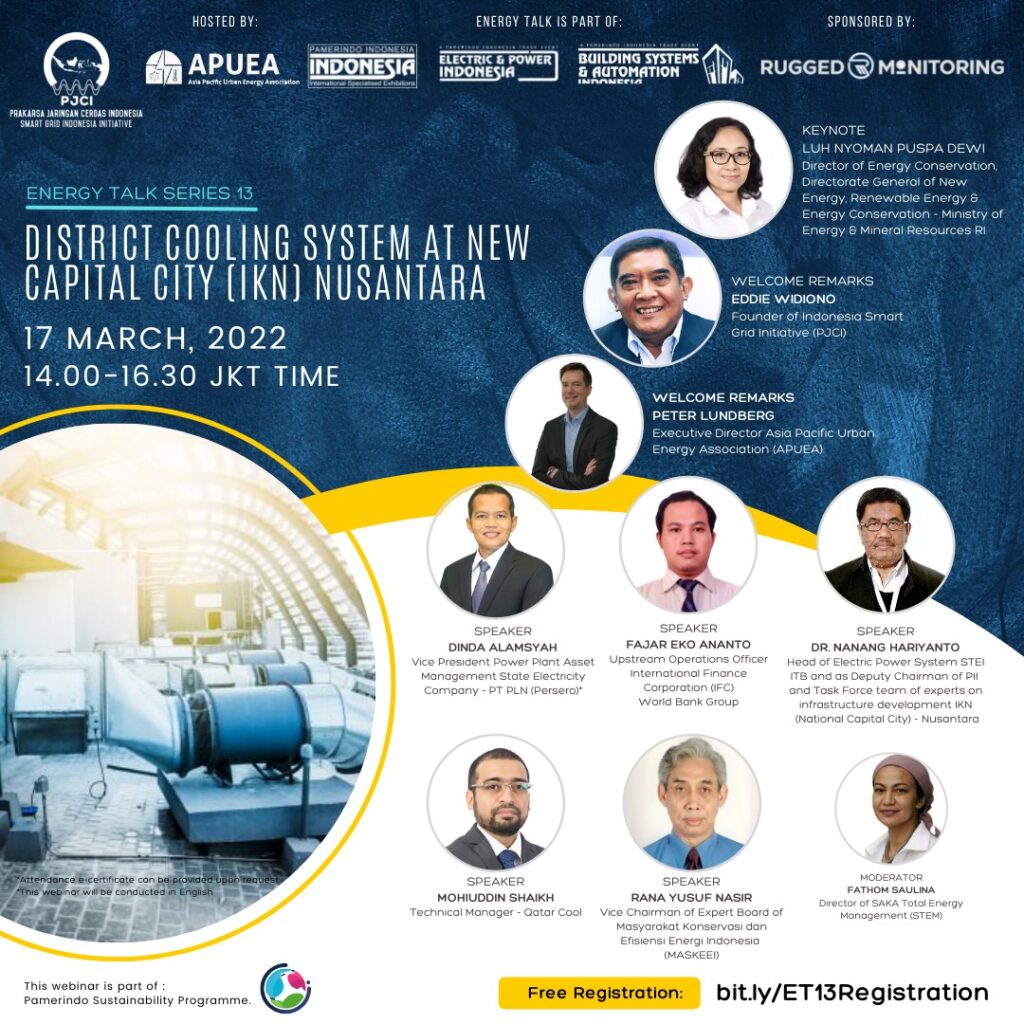
District Cooling System at Indonesia New National Capital
- Introduction
- Title: District Cooling System at Indonesia New National Capital (Ibu Kota Negara Nusantara)
- Date: Thursday, 17 March 2022
- Time: 14.00-16.30 WIB (UTC+7)
- Webinar Platform: Zoom
- Language: English
- Background and Description
Air Conditioners (A/C) are one of the major power-consuming loads at home. The demand for air conditioning in cities can take up to 50-60% of the peak electricity load and create a strain on the power grid. While the operational cost of an air conditioner is dependent on multiple factors, the key ones are the size of the room treated and the margin between atmospheric temperature and the intended temperature. In other words, the warmer the air intake and the lower the user’s intended temperature, more electrical power would be needed for the A/C to operate. Most air conditioners employ an electric pump and two internal electric coils to transfer air between the outdoors and indoors. An evaporator transmits cooler air indoors and a condenser releases warmer air outdoors. A compressor pumps refrigerant between evaporator and condenser, and these refrigerants are the source of the ozone-depleting greenhouse gasses. In many cases, reducing the output of these gasses may reduce the impact of climate change.
Indonesia’s tropical climate and higher average solar intensity results in a warmer atmospheric temperature. Especially during drier seasons. According to the Indonesian Meteorology, Climatology, and Geophysical Agency (BMKG), air temperature during a sunny day at drier season may well reach 38 degree Celsius on average. Under such circumstances, the use of Air Conditioners are common among urban Indonesians. In recent years, the Indonesian government has attempted to increase the efficiency of its national energy use. Such attempts resulted in regulations limiting the use of inefficient cooling systems and at the same time encouraging a transition to a better system of Air Conditioning.
District Cooling is a more sustainable, reliable, and energy effective solution that works by aggregating cooling demand, ideally between multiple residential or commercial buildings in a larger network. The district cooling system comprises a centralized cooling plant which houses large, highly efficient, industrial-grade equipment that supplies chilled water to buildings within its grid through insulated pipelines. The cooling grid can work with power taken from a variety of renewable or clean energy sources, all the while using thermal energy storage technologies to store and supply highly compressed cooled air. These highly efficient systems, if implemented properly, may ease or even accelerate the transition to renewables and cleaner power sources.
Recently, Indonesia was undergoing a process changing its capital from Jakarta to a new, purpose-built site promptly named Ibu Kota Negara baru Nusantara (IKN). These changes may well be a long-awaited momentum in planning a more energy-efficient national capital. One can help in achieving such, is to use a more efficient and greener cooling system. It was expected that the site of the new capital would have on average 26 degree Celsius during wetter season and around 36 degrees during drier ones. All with annual precipitation at 197.49 mm. Were it to be built, the new capital is expected to grow to a center and a new market hotspot for Air Conditioning and District Cooling systems. With climate change in hand, designing a climate-resilient, greener, and more carbon-free city should become the main concern in constructing new cities (especially a new capital).
Henceforth, a discussion is required to examine both potencies and challenges on implementing a well-integrated and energy-efficient District Cooling system in Ibu Kota Negara baru Nusantara. The Webinar “District Cooling System at Indonesia New National Capital (Ibu Kota Negara Nusantara)” is one of the platforms available for such discussion. Followed by exploring the current conditions of the new capital city’s planning, and lastly to come up with solutions in overcoming such challenges or avoiding it altogether. Hosted together with the Asia Pacific Urban Energy Association (APUEA), this webinar is expectedly can bring more information regarding the applications of District Cooling in urban areas of Asia. And hopefully participant can gather insights of the traction and interest of District Cooling system had gained in the Southeast Asian market. Economic evaluation and affordability analysis for private developers in constructing a District Cooling would also be presented. The session will be followed by discussions regarding the effect of District Cooling use had on accelerating energy transitions of Southeast Asian states.
- Purposes
The objectives of this webinar are as follows:
- Creating a platform to increase public awareness regarding the benefits of implementing District Cooling in Indonesia, more specifically on the newly planned capital city.
- Creating a platform that provides deeper knowledge regarding the process, proceedings, and the sustainability of District Cooling implementation on the newly planned capital city
- Creating a platform that discuss the possible challenges on implementing District Cooling in Indonesia.
























